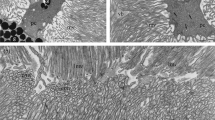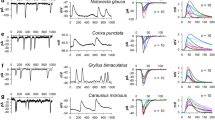Summary
Superfused slices of drone retina were used for a quantitative analysis of light-induced changes in extracellular Ca2+ concentration ([Ca2+]o) and extracellular space (ECS) volume. 20-ms light flashes elicited biphasic changes in [Ca2+]o. For a saturating flash a brief, initial decrease was followed by a transient increase of 120±34 μM. Long, dim steps of light (5 min) produced either a decrease or an increase in [Ca2+]o depending strongly on the previous illumination. Brighter continuous lights caused the [Ca2+]o to increase transiently by 1.4 mM to a peak from which it decayed to a plateau, up to 0.6 mM above the dark concentration.
Light flashes (20 ms) caused a shrinkage in ECS volume not exceeding 4%. Thus, changes in [Ca2+]o were almost completely due to Ca2+ fluxes between the ECS and adjacent cells. Continuous lights caused a shrinkage in ECS volume rarely exceeding 16%–20%. Thus, less than 15% of the measured Ca2+ changes could be attributed to shrinkage of the ECS. These data confirm that the ECS functions as a source and a sink for Ca2+ mobilized by light. For comparison, we also made a few measurements of changes in [Ca2+]o in the retina ofCalliphora.
Similar content being viewed by others
Abbreviations
- [Ca 2+]i :
-
intracellular free Ca2+ concentration
- [Ca 2+]o :
-
extracellular free Ca2+ concentration
- ECS :
-
extracellular space
- ER :
-
endoplasmic reticulum
- TMA + :
-
tetramethylammonium ion
References
Bader CR, Baumann F, Bertrand D (1976) Role of intracellular calcium and sodium in light adaptation in the retina of the honey bee drone (Apis mellifera). J Gen Physiol 67:475–491
Baumann F (1974) Electrophysiological properties of the honey bee retina. In: Horridge GA (ed) The compound eye and vision in insects. Clarendon, Oxford, pp 53–74
Baumann O, Walz B (1989) Topography of Ca2+-sequestering endoplasmic reticulum in photoreceptors and pigmented glial cells in the compound eye of the honey bee drone. Cell Tissue Res 255:511–522
Baumann O, Walz B (1989) Calcium- and inositol polyphosphate-sensitivity of the calcium-sequestering endoplasmic reticulum in the photoreceptor cells of the honeybee drone. J Comp Physiol A 165:627–636
Bertrand D, Fuortes G, Muri R (1979) Pigment transformation and electrical responses in retinula cells of drone,Apis mellifera. J Physiol 296:431–441
Bolsover SR, Brown JE (1985) Calcium ion, an intracellular messenger of light adaptation, also participates in excitation ofLimulus ventral photoreceptor cells. J Physiol 364:389–393
Brown JE (1986) Calcium and light adaptation in invertebrate photoreceptors. In: Stieve H (ed) The molecular mechanism of photoreception. Springer, Berlin Heidelberg New York, pp 231–240
Brown JE, Blinks JR (1974) Changes in intracellular free calcium concentration during illumination of invertebrate photoreceptors. Detection with aequorin. J Gen Physiol 64:643–665
Brown JE, Mote MI (1974) Ionic dependence of reversal voltage of the light response inLimulus ventral photoreceptors. JGen Physiol 63:337–350
Carafoli E (1987) Intracellular calcium homeostasis. Annu Rev Biochem 56:395–433
Coles JA, Orkand RK (1983) Modification of potassium movement through the retina of the drone (Apis mellifera) by glial uptake. J Physiol 340:157–174
Coles JA, Orkand RK (1985) Changes in sodium activity during light stimulation in photoreceptors, glia, and extracellular space in drone retina. J Physiol 362:415–435
Coles JA, Orkand RK, Yamate CL, Tsacopoulos M (1986) Free concentrations of Na, K, and Cl in the retina of the honey bee drone: Stimulus-induced redistribution and homeostasis. Ann NY Acad Sci 481:303–317
Coles JA, Tsacopoulos M, Rabineau P, Gardner-Medwin AR (1981) Movements of potassium into glial cells in the retina of the drone,Apis mellifera, during photostimulation. In: Syková E (ed) Ion selective microelectrodes and their use in excitable tissue. Plenum, New York, pp 345–349
Connors BW, Ransom BR, Kunis DM, Gutnik MJ (1982) Activity-dependent K+ accumulation in the developing rat optic nerve. Science 216:1341–1343
Dietzel I, Heinemann U, Hofmeier G, Lux HD (1980) Transient changes in the size of the extracellular space in the sensomotor cortex of cats in relation to stimulus-induced changes in potassium concentration. Exp Brain Res 40:432–439
Fein A, Charlton JS (1977) Increased intracellular sodium mimics some but not all aspects of photoreceptor adaptation in the ventral eye ofLimulus. J Gen Physiol 70:601–620
Fulpius B, Baumann F (1969) Effects of sodium, potassium and calcium ions on slow and spike potentials in single photoreceptor cells. J Gen Physiol 53:541–561
Hagins WA, Zonana HV, Adams RG (1962) Local membrane current in the outer segments of squid photoreceptors. Nature 194:844–847
Hansen AJ, Olsen CE (1980) Brain extracellular space during spreading depression and ischemia. Acta Physiol Scand 108:355–365
Hochstrate P, Hamdorf K (1985) The influence of extracellular calcium on the response of fly photoreceptors. J Comp Physiol A 156:53–64
Hodgkin AL, McNaughton PA, Nunn BJ (1985) The ionic selectivity and calcium dependence of the light-sensitive pathway in toad rods. J Physiol 358:447–468
Ivens I, Stieve H (1984) Influence of the membrane potential on the intracellular light induced Ca2+ concentration change of theLimulus ventral photoreceptor monitored by Arsenazo III under voltage clamp conditions. Z Naturforsch 39c:986–992
Lasansky A, Fuortes MGF (1969) The site of origin of electrical responses in visual cells of the leech,Hirudo medicinalis. J Cell Biol 42:241–252
Lisman JE, Brown JE (1972) The effects of intracellular iontophoretic injection of calcium and sodium ions on the light response ofLimulus ventral photoreceptors. J Gen Physiol 59:701–719
Maaz G, Stieve H (1980) The correlation of the receptor potentials with the light-induced transient increase in intracellular Ca concentration measured by absorption change of A III injected intoLimulus ventral nerve photoreceptor cells. Biophys Struct Mech 9:207–223
Miller DL, Korenbrot JI (1987) Kinetics of light-dependent Ca fluxes across the plasma membrane of rod outer segments. J Gen Physiol 90:397–425
Minke B, Armon E (1984) Activation of electrogenic Na-Ca exchange by light in fly photoreceptors. Vision Res 24:109–115
Minke B, Tsacopoulos M (1986) Light induced sodium dependent accumulation of calcium and potassium in the extracellular space of bee retina. Vision Res 26:679–690
Muijser H (1979) The receptor potential of retinular cells of the blowfly,Calliphora: the role of sodium, potassium and calcium ions. J Comp Physiol 132:87–95
Munoz JL, Deyhimi F, Coles JA (1983) Silanization of glass in the making of ion-sensitive microelectrodes. J Neurosci Meth 8:231–247
O'Day PM, Lisman JE, Goldring M (1982) Functional significance of voltage-dependent conductances inLimulus ventral photoreceptors. J Gen Physiol 79:211–232
Oehme M, Simon W (1976) Microelectrode for potassium ions based on a neutral carrier and comparison of its characteristics with a cation exchanger sensor. Anal Chim Acta 86:21–25
Oehme M, Kessler M, Simon W (1976) Neutral carrier Ca2+- microelectrode. Chimia 30:204–206
Orkand RK, Dietzel I, Coles JA (1984) Light-induced changes in extracellular volume in the retina of the drone,Apis mellifera. Neurosci Lett 45:273–278
Payne R, Fein A (1986) Localization of the photocurrent ofLimulus ventral photoreceptors using a vibrating probe. Biophys J 50:193–196
Payne R, Corson DW, Fein A, Berridge MJ (1986) Excitation and adaptation ofLimulus ventral photoreceptor by inositol (1,4,5,) trisphosphate results from a rise in intracellular calcium. J Gen Physiol 88:127–142
Payne R, Walz B, Levy S, Fein A (1988) The localization of calcium release by inositol trisphosphate inLimulus photoreceptors and its control by negative feedback. Phil Trans R Soc B 320:359–379
Perrelet A, Bader CR (1978) Morphological evidence for calcium stores in photoreceptors of the honey bee drone retina. J Ultrastruct Res 63:237–243
Phillips JM, Nicholson C (1979) Anion permeability in spreading depression investigated with ion-sensitive microelectrodes. Brain Res 173:567–571
Raggenbass M (1983) Effects of extracellular calcium and of light adaptation on the response to dim light in honey bee drone photoreceptors. J Physiol 344:527–548
Sandler C, Kirschfeld K (1988) Light intensity controls extracellular Ca2+ concentration in the blowfly retina. Naturwissenschaften 75:256–258
Tsien RY, Rink TJ (1980) Neutral carrier ion-selective microelectrodes for measurement of intracellular free calcium. Biochim Biophys Acta 599:623–638
Waloga G, Brown JE, Pinto LH (1975) Detection of changes in Ca(in) fromLimulus ventral photoreceptors using arsenazo III. Biol Bull 149:449–450
Walz B (1982) Calcium-sequestering endoplasmic reticulum in retinula cells of the blowfly. J Ultrastruct Res 81:240–248
Walz B (1985) Light-induced changes of extra- and intracellular potassium concentration in photoreceptors of the leechHirudo medicinalis. J Comp Physiol A 157:199–210
Walz B, Coles JA, Poitry S, Levy S (1986) Helladaptation und lichtinduzierte Zunahme der intrazellulären Ca2+ (und Na+) Konzentration sind in den Photorezeptoren der Biene räumlich lokalisiert. Verh Dtsch Zool Ges 79:245–246
Walz B, Ziegler A, Baumann O (1988) Extracellular space (ECS) and endoplasmic reticulum (ER) as sources and sinks for Ca2+ mobilized by light in photoreceptors of the honey bee drone. In: Elsner E, Barth FG (eds) Sense organs. Thieme, Stuttgart, p 209
Yau K-W, Nakatani K (1984) Cation selectivity of light-sensitive conductance in retinal rods. Nature 309:352–354
Yau K-W, Nakatani K (1985) Light-induced reduction of cytoplasmic free calcium in retinal rod outer segment. Nature 313:579–582
Author information
Authors and Affiliations
Rights and permissions
About this article
Cite this article
Ziegler, A., Walz, B. Analysis of extracellular calcium and volume changes in the compound eye of the honeybee drone,Apis mellifera . J. Comp. Physiol. 165, 697–709 (1989). https://doi.org/10.1007/BF00611001
Accepted:
Issue Date:
DOI: https://doi.org/10.1007/BF00611001




